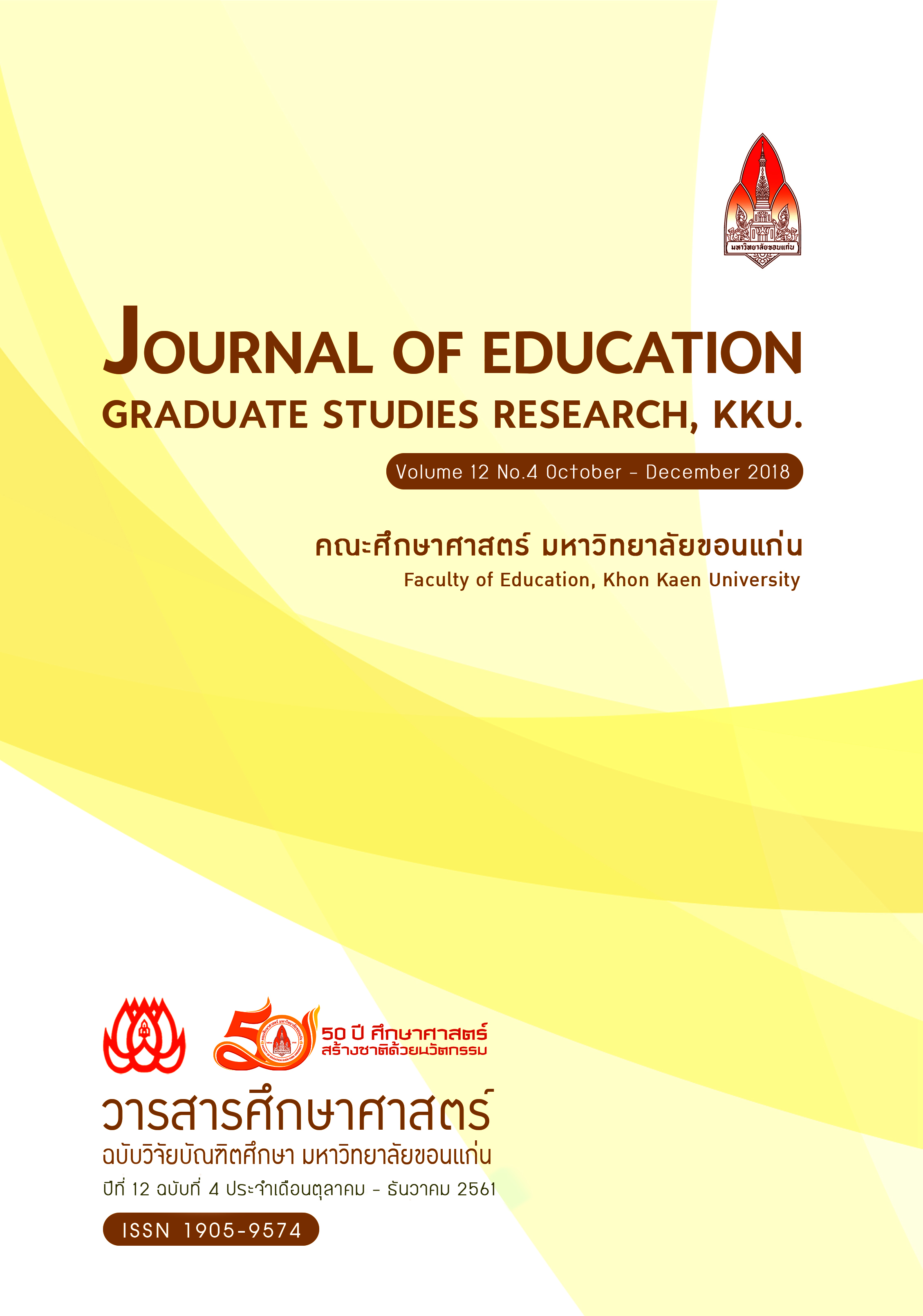A Comparison of Problem Solving Ability in Science of Students Studying with Blended Learning Using Group Investigation Technique with Social Media Integration to Enhance Problem Solving Ability in Science of Grade VI Students
Main Article Content
Abstract
The purpose of this research was to compare problem-solving ability in the science of students studying with blended learning using group investigation techniques with social media integration to enhance problem-solving ability in the science of Sixth-grade students. It is a quasi-experimental research with randomized one-group pretest-posttest design. Forty-eight students enrolling in the first semester of the academic year 2017 at Ban Nong Bua Sarng Witthayakhan School, Aum Chan Sub-district, Kusuman District, Sakon Nakhon, under Office of Sakon Nakhon Primary Education Service Area 1 were selected as the target group. Research instruments included blended learning materials on surrounding substances and tests of problem-solving ability in science. Mean, percentage, standard deviation, and t-test were used for data analysis.
The research result found:
After the students applied blended learning using group investigation technique with social media integration to enhance their problem solving ability in science, their score was higher than before the application at a significant level of 0.05.
Article Details
References
สำนักงานเลขาธิการสภาการศึกษากระทรวงศึกษาธิการ. (2559). สมรรถนะการศึกษาไทยในเวทีสากล ปี 2559 (MID 2016). Retrieved December 27, 2017, from http://backoffice.onec.go.th/uploads/Book/1531-file.pdf
เฉลิมชัย กาญชนคเชนทร์ และ สมเกียรติ พรพิสุทธิมาศ. (2558). การศึกษาความสามารถในการคิดแก้ปัญหาทางวิทยาศาสตร์ของนักเรียนชั้นมัธยมศึกษาตอนปลายในรายวิชาชีววิทยา ที่ได้รับการจัดการเรียนรู้โดยใช้ปัญหาเป็นฐาน. Retrieved December 25, 2017, from http://conference.edu.ksu.ac.th/file/201608094924669212.pdf
ทิศนา แขมณี. (2558). ศาสตร์การสอนองค์ความรู้เพื่อการจัดกระบวนการเรียนรู้ที่มีประสิทธิภาพ. พิมพ์ครั้งที่ 19. กรุงเทพฯ: จุฬาลงกรณ์มหาวิทยาลัย.
พิมพ์ใจ เกตุการณ์, สพลณภัทร์ ศรีแสนยงศ์ และ สมศิริ สิงห์ลพ. (2560). ผลการจัดการเรียนรู้โดยใช้ปัญหาเป็นฐานเพื่อพัฒนาผลสัมฤทธิ์ทางการ เรียนวิชาวิทยาศาสตร์ ความสามารถในการ แก้ปัญหาและเจตคติทางวิทยาศาสตร์ ของนักเรียนชั้นประถมศึกษาปีที่ 6. วารสารศึกษาศาสตร์ มหาวิทยาลัยนเรศวร, 19(1), 77-89.
วิสุทธิ์ ตรีเงิน. (2558). การพัฒนาความสามารถในการ แก้ปัญหาทางวิทยาศาสตร์ด้วยโครงงาน วิทยาศาสตร์. Retrieved December 25, 2017, from http://www.dpu.ac.th/dpurc/assets/uploads/magazine/ r2ruupv662ow84.pdf
Gallenstein, N. L. (2016). Group Investigation: An Introduction to Cooperative Research. Retrieved December 28, 2017, from http://www.socialstudies.org/system/files/ publications/yl/1301/130106.html
Garrison, D. R., and Vaughan, N. D. (2008). Blended learning in higher education: framework, principle, guidelines, 1 and. San Francisco: A Wiley Imprint.
Tan et al. (2006). Group investigation and Student Learning: An experiment in Singapore Schools. Singapore, Marshall Cavendish Academic.
Jonassen, D. H. (2011). Learning to Solve Problem: A Handbook for Designing Problem Solving Learning Environments. New York: Routledge.
Lopez-Perez, M. V., Perez-Lopez, M. C. & Rodrigues-Ariza, L. (2011). Blended learning in higher education: Students’ perceptions and their relation to outcomes. Computers & Education, 56(3), 818-826.
Piaget, S. (1962). The language and thoughts of the child. Cleveland: Merdian.
Weir, J. J. (1974). Problem Solving is Everybody’s Problem. Science Teacher, 41(4), 16 –18.

